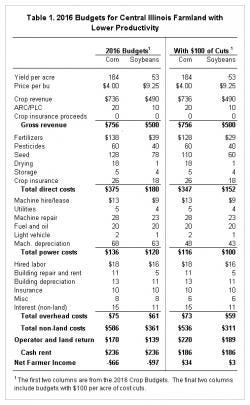August 7, 2015

Given farm revenues in 2016 budget projections, costs must be reduced to have positive returns. Cost cuts of $100 per acre will be used at the target. Cuts of $100 per acre would result in $19 per acre of net farmer income, levels that are relatively low and do not provide much margin. A $100 cost cut implies total cost reductions of 12% for corn and 17% for soybeans. These are very large cost reductions.
Cost cuts of $100 can be achieved in a variety of ways. Experts at the University of Illinois used a sample farm budget for 2016 and reduced costs by $100 per acre. Here's how:
Cash rent was reduced by $50 per acre from $236 per acre to $186 per acre. It was decided to split cost reductions between cash rent and non-land costs. Placing all cost cuts on non-land costs would result in a $136 per acre cash rent, roughly the same level as from 2004 through 2006.
Misc expenses were reduced by $2 per acre from $8 per acre to $6 per acre, indicating a general emphasis on cost control.
Machinery depreciation was reduced $20 per acre. For corn, this resulted in a reduction from $68 per acre down to $48 per acre. Reducing depreciation requires that capital purchases are very low. The $20 reduction assumes that capital expenditures are near $0 per acre. Even given a $0 target, it is not assured that machinery depreciation could be reduced by $20 per acre; however, near $0 in capital purchase would impact cash flows.
Fertilizer costs were reduced by $10 per acre. For corn, this results in fertilizer costs from $138 per acre to $128 per acre. These costs are reduced either through lower rates. Hopefully, some price reductions in fertilizer costs may occur.
Seed costs were reduced by $18 per acre. For corn, this would reduce seed costs from $128 per acre to $110 per acre. How this cost reduction occurs is not exactly certain. Seeding rates may need to be lowered, and hybrids with lower technology may need to be purchased. Perhaps some price relief will exist for 2016 hybrids and varieties.
Focus of cost cuts

Click for larger table.
In the example, the majority of non-land cost cuts were made to fertilizers, seed, and machinery depreciation. These three costs accounted for 71% of cost increases between 2006 through 2013 (see farmdoc daily September 16, 2014). These three costs plus pesticide costs account for 67% of non-land costs for corn and 61% for soybeans. Cost costs in these four areas must occur if sizable reductions in non-land costs are to occur.
Price increases could be same as $100 cost decrease
Higher commodity prices could have the same impact on net farm income as cost reductions. A corn price of $4.65 for corn and $10.75 for soybeans results in the same income as $100 in cuts. The $4.65 corn price and $10.75 soybean price are close to projections of the long-run averages (farmdoc daily February 27, 2013). At these prices, income would be $19 per acre, a relatively low level, suggesting that costs need to be reduced even if prices approach projected long-run averages.
You May Also Like




